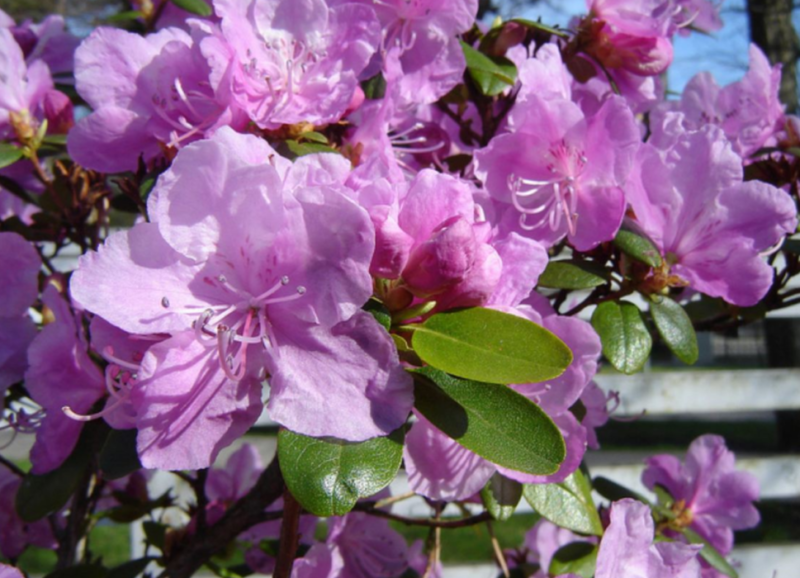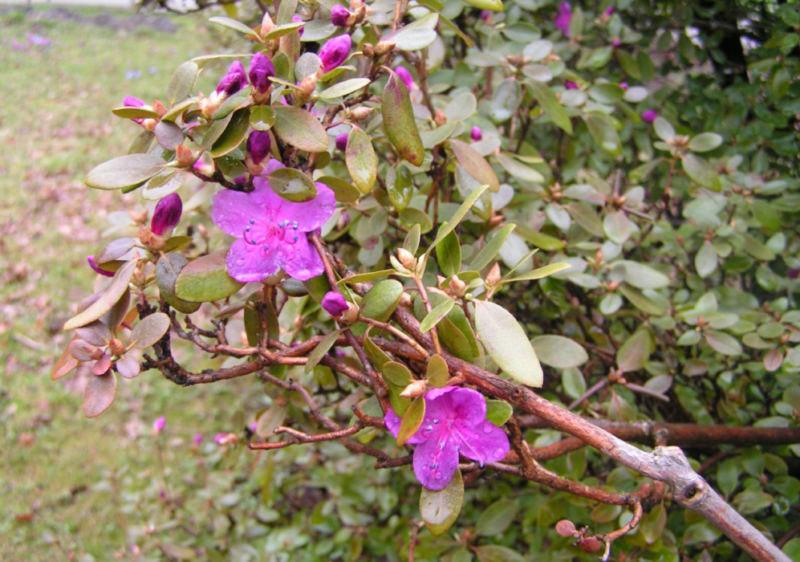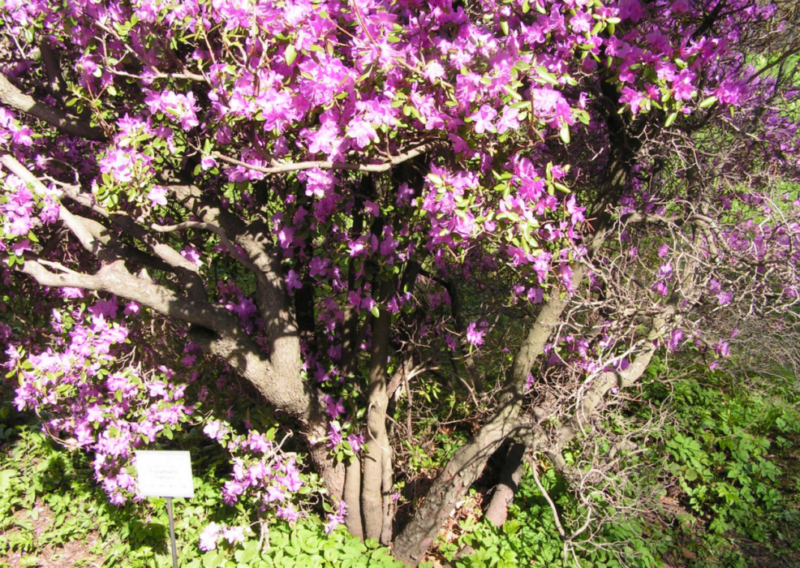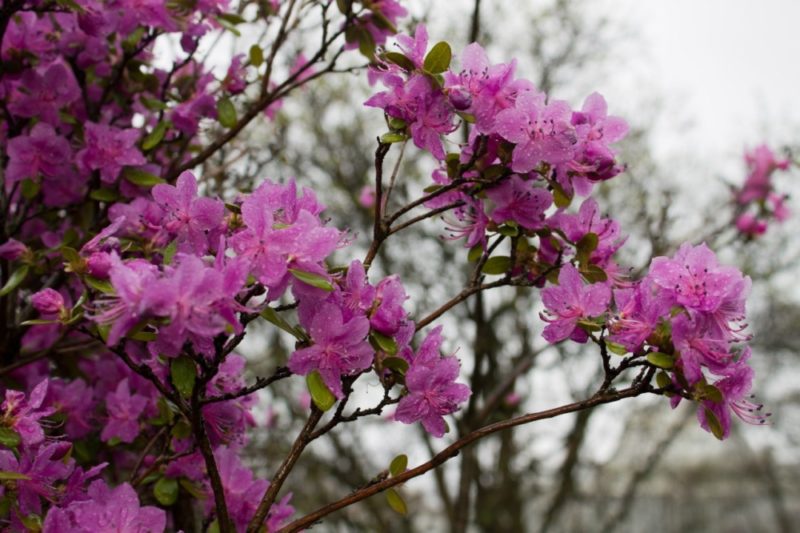Rhododendron Ledebur is one of the earliest flowering shrubs. Frost-resistant: withstands frosts down to -320С. The plant is named after the German botanist who served in Russia and took part in an expedition to Altai.
Material Content:
Description of the species of rhododendron Ledebour
In wildlife, this species is found in northeast Mongolia, in the Sayan Mountains, Altai, in the subalpine zone of the mountains, and as an undergrowth in coniferous forests.
Type Description:
- Semi-evergreen shrub belonging to the heather family.
- It has several names: maralnik, Siberian rosemary, daurian rhododendron.
- In appearance it is a branchy leafy plant, the branches of which stretch upward.
- The trunk and branches of the bark are dark gray in color. Young shoots are glandular-scaly, short pubescent.
- The leaves are olive green, covered with scaly-like glands.
- The bush hibernates leafy. Leaves are preserved until the end of flowering, and then fall and new ones grow.
- In severe frosts, the leaves fold into tubes and open when heat occurs.
- Sometimes blooms twice. The first flowering is in April-June, the second is in August-September. The flowers are pink and purple.
- The tree reaches a height of 1.5 - 2 m.
Outdoor landing
Rhododendron prefers acidic, breathable soils.
The best composition for him:
- peat;
- needles;
- sheet earth.
Components are taken in equal parts. The trunk circle is mulched because the plant has sensitive roots. Mulch retains moisture and protects the soil from overheating. You can use pine needles or bark. The thickness of the mulching layer should be at least 5 cm.
Rhododendron is planted in early spring. It is very important to choose the right place. It should be shady.Indeed, in nature, the bush grows in the shadow of high neighbors. The landing hole is made 2-3 times larger than the root system. The seedling is set in the center, the roots are straightened and covered with the prepared soil mixture. Lightly tamp and thoroughly watered.
Care for the semi-evergreen shrub
Leaving includes watering, cutting, top dressing, loosening and weeding.
Watered abundantly in the summer, do not allow the soil to dry out. In the fall, watering is reduced, closer to winter it is not produced at all. The plant loves moist air, so spraying foliage will bring undoubted benefit. Water and spray with settled water.
Rhododendron of Ledebour needs pruning to form a crown. It is carried out in the spring. Twigs cut more than 2 cm in diameter. Places of cuts are covered with garden varnish to prevent infection. Sleeping kidneys after pruning begin to grow actively. For a longer and more abundant flowering, wilted inflorescences are pruned. In place of the remote, new ones are emerging. Vegetative buds can be plucked to enhance branching.
Formative pruning delays growth and flowering. Better to use plucking.
The most optimal option for feeding young plants is liquid fertilizers in a limited dosage. With a deficiency of minerals, the leaves turn yellow, the growth of shoots slows down.
Adult plants are fed with special long-acting formulations for rhododendrons. They are brought in once a season - in early spring.
At the same time, you can feed organics using a well-rotted compost or mullein.
Breeding methods
Propagating rhododendrons, especially wild ones, is simple.
To do this, you can use one of the following methods:
- by seeds;
- cuttings;
- layering.
The most difficult way is seed propagation. Sow seed in boxes with drainage holes. The soil is pre-disinfected, not watered before sowing.
Seeds are mixed with sand and rarely sown, at a distance of 1-1.5 cm. The soil is not covered. Watered through a strainer, covered with a film or glass, left at room temperature. After the emergence of seedlings, the container with seedlings is rearranged in a cool place where + 8-120С is supported. You need to water through the pan, if possible turn on the backlight.
Dive in June, transplanting into large boxes. In the fall, containers are brought into the room with a temperature of 8 to + 180 ° C. Seedlings are highlighted until 16-18 hours. In February, they dive a second time. In the summer they take to the garden. Autumn return to the room. In the open ground planted in the third year.
Plants grown from seeds are planted in a permanent place for 4 or 5 years.
When propagated by cuttings, they are cut in the first half of summer. Semi-lignified annual shoots 7-10 cm long are cut from the bush. The lower leaves are removed, leaving 2-3 upper ones. The slice is made at an angle of 450.
Soak in the stimulator for 15-24 hours. Planted in a specially prepared substrate or in a mixture of peat and sand, taking them in equal proportions.
Cuttings are buried at an angle of 300. Compress and water. The container is covered with a transparent cap or film. At the same time, they make sure that the film does not come into contact with the cuttings.
The room maintains a temperature of +25 to + 300C, a stable high humidity of the substrate and air.
Rooting can occur after 3 weeks or 4-5 months, depending on the plant variety. Saplings from cuttings are planted in a permanent place for 3-4 years.
Rooting by layering is carried out as follows:
- on the stem, in contact with the soil, make a longitudinal incision, insert a match or sliver into it;
- deepen the soil in the place where they will make the tide;
- a twig with an incision is bent to the ground and fixed with a hairpin or bracket;
- sprinkled with acidic soil (a mixture of peat and garden soil), carefully tamped, mulched;
- the upper part is directed upwards, tied to a support.
In the fall layering can be planted. In places with a harsh climate, it is better to plant in the spring.
You can get planting material by cultivating the base of a plant with light acid soil. With constant soil moisture, even without nailing, the next year they get a lot of rooted shoots.
Pest and Disease Control
Rhododendrons are affected by many different insects. In order to prevent the death of plants, they need to be constantly examined and, at the first signs of pests, fight them.
Rhododendron pests include:
- acacia false shield;
- spider mite;
- tobacco thrips;
- gardener;
- corrugated bevel;
- mole miner;
- mealybug;
- rhododendron fly;
- blueberry moth;
- sawfly;
- whitefly;
To combat insects, the following insecticides are treated:
- Contact: Clipper;
- contact-intestinal: Actellik, Intra-Vir, Karate, Karbofos;
- system: Bi-58, Aktara, Condor.
The following diseases develop on rhododendrons:
- tracheomycosis causes root rot. The trees are sprayed with a Bordeaux mixture. Patients are burned;
- late blight rot, gray, buds, seedlings and young shoots. Copper preparations help cope with all types of rot;
With high humidity and low temperature, preparations with copper cause burns on leaves and young shoots.
- Spotting is septorious. Use Bordeaux liquid in the spring. In the summer, fungicides Fundazol, Topaz, Gamair are used.
- The dying off of shoots. Most often happens with plants planted in full shade. The affected parts are cut and burned. The bushes are treated with preparations containing copper every 2 weeks.
- Root rot. It develops in waterlogged areas and insufficiently acidic soils. Infected rhododendrons burn, increase soil acidity, regulate watering.
- Dry white rot of the root neck. At the first signs of this disease, the affected bushes are dug up and burned, and those located nearby are transplanted away, without covering the neck with mulch.
- Wax disease. The fungus that causes the disease dies during spring treatment with Bordeaux fluid.
- Spotting: pestalocytic, anthracotic, phyllactic. The fight against them consists in spraying plants in spring with Bordeaux liquid, its substitutes - Cumulus. The affected parts are cut and burned.
- Sheet mosaic. Ill bushes destroy. To prevent the progression of the disease, they fight insect vectors.
- Rust. Spray with drugs containing copper.
- Bacterial cancer of the root system. Heavily affected plants are burned, the rest are sprayed with a solution of Bordeaux fluid.
- Chlorosis. The bushes are sprayed with a mixture of iron and magnesium sulfate (7 g of the drug per 1 liter of water).
Rhododendron Ledebour is a beautiful early flowering plant that will decorate your garden. Proper care and attentive attitude will allow you to admire the beautiful flowering for many years.

















